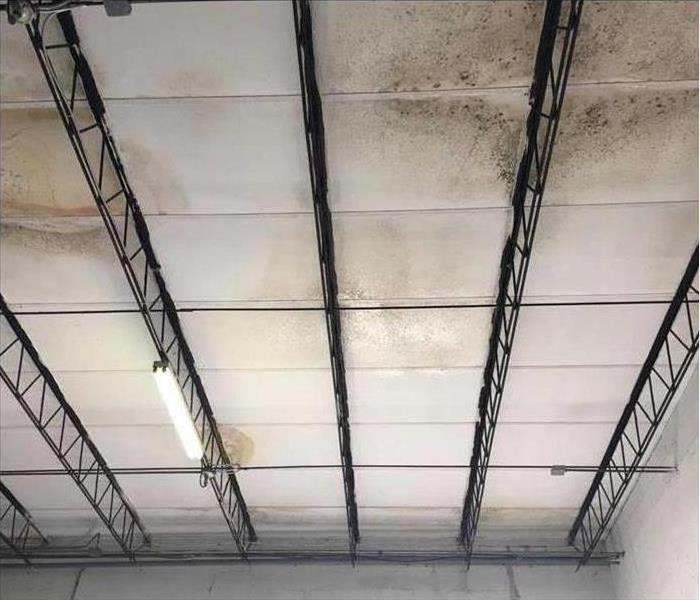Know the Facts: Mold Growth & Remediation
11/21/2022 (Permalink)
How Does Mold Spread in My Home?
Molds will grow where conditions allow. Molds require two things to grow – a food source and moisture. Food sources can be anything from dry wall and insulation to carpeting or mattresses. Moisture can come from many sources, including high humidity levels, leaky pipes or appliance hoses, neglected or inadequately repaired roofs, improperly maintained air conditioners, landscape and drainage problems, etc.
Should I be Concerned About Mold in My Home?
Yes. Indoor mold growth is unsanitary and undesirable. If you can see or smell mold inside your home, you should take steps to eliminate the cause by cleaning up and removing the mold. If left unchecked, mold growth can cause health effects and structural damage to your home.
What Can I Do to Prevent Mold From Growing in My Home?
Since mold needs a food source and moisture to grow, the best thing you can do is to prevent moisture problems that allow mold to grow.
- Maintain lower levels of humidity in your home (preferably between 30-50%) by: venting bathrooms and dryers to the outside; using air conditioners and de-humidifiers; increasing ventilation by adding crawlspace and attic vents; using exhaust fans when cooking, dishwashing, and cleaning, etc.
- Add insulation to reduce the potential for condensation on cold surfaces such as windows, pipes, exterior walls, roofs, or floors.
- Inspect your home regularly for indications and sources of indoor moisture such as leaking pipes, appliance hoses, showers, tubs, sinks and toilets. Replace plastic hoses with steel-reinforced hoses. Check windows, doors, attics and ceilings for leaks or evidence of water stains or odors, particularly after rains. Fix plumbing, flashing, and roof leaks right away.
- Don't carpet bathrooms, basements, kitchens or other areas prone to moisture. Clean bathrooms often and keep surfaces dry.
- Cover dirt in crawlspaces with a moisture barrier plastic sheeting.
- Prevent water from entering basements and crawlspaces by repairing holes and cracks in walls and foundation. Use landscaping to direct water away from your foundation.
- Clean and maintain your gutters and make sure drainpipes carry water several feet away from your home.
- Watch your utility bills. An abnormally high water bill could signal a water leak.
- Before you travel, turn off the water at the main valve. Have a trusted friend or neighbor check the inside and outside of your home periodically while you're away.
Where Does Mold Like to Live?
Just hearing the word “mold” can cause us all to cringe. It’s odorous, unsightly, and even dangerous to our health. Mold growth can appear quickly, so knowing where to look and what areas are best to practice preventive measures in can help give you peace of mind.
Here are the top three areas to check regularly for mold growth:
The Bathroom
Everyone knows that mold likes water and wet areas, making your bathrooms a hotbed for mold growth. Most bathrooms are cleaned thoroughly at least once a week, this is a great time to check for mold. Look in the least traveled areas, such as corners of the linen closet, behind the toilet, under the sink. If there are, or have been, any leaks in these places in the past, these areas are in danger until they are fully dry. Investing in a dehumidifier for your bathroom can assist in the prevention of mold growth.
The Kitchen
This area of your home is also a watery place; it is used more than any other area in the house besides the bath. Watch out for spills and leaks. Clean them up immediately to ensure that they are not attracting mold spores. Spores are always in our air and cannot be removed, the trick to preventing mold growth is not giving them a place to land and settle.
The laundry room
Because the laundry room houses large appliances, it also has nooks and crannies that are not cleaned often. Add to that the humidity in the air and possible unseen leaks or drips, and you have a recipe for the establishment of a mold colony. Pull the washer and dryer out from the wall regularly, and make sure the areas behind them are clean, dry, and disinfected in order to prevent mold growth.
Other areas to check frequently for mold include hall closets, garages, and basements.
Our team at SERVPRO of North Richland and Ashland Counties is always here to help you with any issues related to mold remediation in your home or business. Large-scale cleanups after flooding and fire are our specialties.
Returning your home to its pre-mold condition is not a quick or easy set of processes. SERVPRO of North Richland and Ashland County has years of experience in helping our customers through each step to put you back into your home. If you need us, call (419) 207-8449 today to set up an inspection.






 24/7 Emergency Service
24/7 Emergency Service
